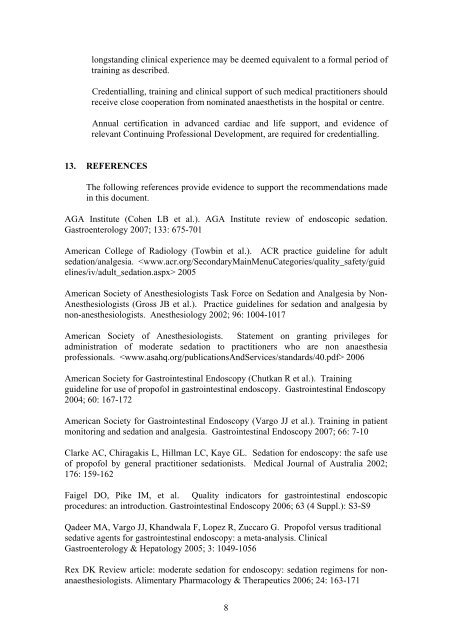clinical indicators - Australian and New Zealand College of ...
clinical indicators - Australian and New Zealand College of ...
clinical indicators - Australian and New Zealand College of ...
Create successful ePaper yourself
Turn your PDF publications into a flip-book with our unique Google optimized e-Paper software.
longst<strong>and</strong>ing <strong>clinical</strong> experience may be deemed equivalent to a formal period <strong>of</strong>training as described.Credentialling, training <strong>and</strong> <strong>clinical</strong> support <strong>of</strong> such medical practitioners shouldreceive close cooperation from nominated anaesthetists in the hospital or centre.Annual certification in advanced cardiac <strong>and</strong> life support, <strong>and</strong> evidence <strong>of</strong>relevant Continuing Pr<strong>of</strong>essional Development, are required for credentialling.13. REFERENCESThe following references provide evidence to support the recommendations madein this document.AGA Institute (Cohen LB et al.). AGA Institute review <strong>of</strong> endoscopic sedation.Gastroenterology 2007; 133: 675-701American <strong>College</strong> <strong>of</strong> Radiology (Towbin et al.). ACR practice guideline for adultsedation/analgesia. 2005American Society <strong>of</strong> Anesthesiologists Task Force on Sedation <strong>and</strong> Analgesia by Non-Anesthesiologists (Gross JB et al.). Practice guidelines for sedation <strong>and</strong> analgesia bynon-anesthesiologists. Anesthesiology 2002; 96: 1004-1017American Society <strong>of</strong> Anesthesiologists. Statement on granting privileges foradministration <strong>of</strong> moderate sedation to practitioners who are non anaesthesiapr<strong>of</strong>essionals. 2006American Society for Gastrointestinal Endoscopy (Chutkan R et al.). Trainingguideline for use <strong>of</strong> prop<strong>of</strong>ol in gastrointestinal endoscopy. Gastrointestinal Endoscopy2004; 60: 167-172American Society for Gastrointestinal Endoscopy (Vargo JJ et al.). Training in patientmonitoring <strong>and</strong> sedation <strong>and</strong> analgesia. Gastrointestinal Endoscopy 2007; 66: 7-10Clarke AC, Chiragakis L, Hillman LC, Kaye GL. Sedation for endoscopy: the safe use<strong>of</strong> prop<strong>of</strong>ol by general practitioner sedationists. Medical Journal <strong>of</strong> Australia 2002;176: 159-162Faigel DO, Pike IM, et al. Quality <strong>indicators</strong> for gastrointestinal endoscopicprocedures: an introduction. Gastrointestinal Endoscopy 2006; 63 (4 Suppl.): S3-S9Qadeer MA, Vargo JJ, Kh<strong>and</strong>wala F, Lopez R, Zuccaro G. Prop<strong>of</strong>ol versus traditionalsedative agents for gastrointestinal endoscopy: a meta-analysis. ClinicalGastroenterology & Hepatology 2005; 3: 1049-1056Rex DK Review article: moderate sedation for endoscopy: sedation regimens for nonanaesthesiologists.Alimentary Pharmacology & Therapeutics 2006; 24: 163-1718
















